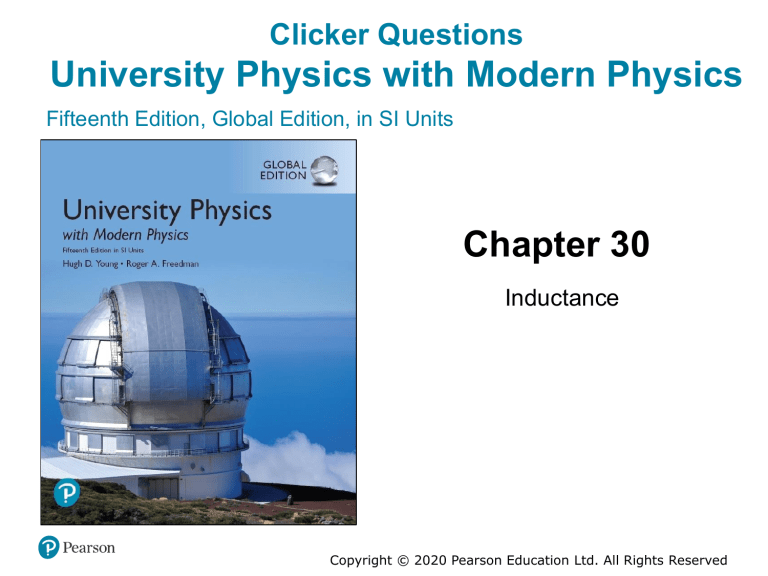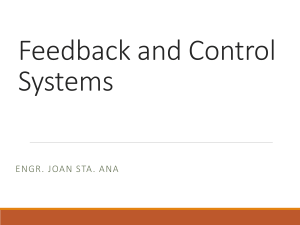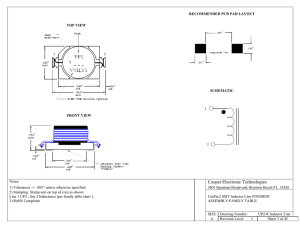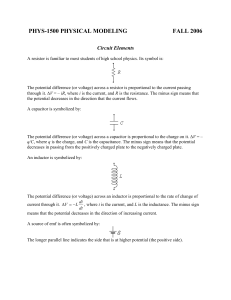
Clicker Questions University Physics with Modern Physics Fifteenth Edition, Global Edition, in SI Units Chapter 30 Inductance Copyright © 2020 Pearson Education Ltd. All Rights Reserved Q30.1 A small, circular ring of wire (shown in blue) is inside a larger loop of wire that carries a current I as shown. The small ring and the larger loop both lie in the same plane. If I increases, the current that flows in the small ring Large loop Small ring A. is clockwise and caused by self-inductance. B. is counterclockwise and caused by self-inductance. C. is clockwise and caused by mutual inductance. D. is counterclockwise and caused by mutual inductance. E. is zero, since the two rings of wire are not connected. © 2020 Pearson Education Ltd. I I A30.1 A small, circular ring of wire (shown in blue) is inside a larger loop of wire that carries a current I as shown. The small ring and the larger loop both lie in the same plane. If I increases, the current that flows in the small ring Large loop Small ring A. is clockwise and caused by self-inductance. B. is counterclockwise and caused by self-inductance. C. is clockwise and caused by mutual inductance. D. is counterclockwise and caused by mutual inductance. E. is zero, since the two rings of wire are not connected. © 2020 Pearson Education Ltd. I I Q30.2 A current i flows through an inductor L in the direction from point b toward point a. There is zero resistance in the wires of the inductor. If the current is decreasing, A. the potential is greater at point a than at point b. B. the potential is less at point a than at point b. C. the answer depends on the magnitude of di/dt compared to the magnitude of i. D. the answer depends on the value of the inductance L. E. both C and D are correct. © 2020 Pearson Education Ltd. A30.2 A current i flows through an inductor L in the direction from point b toward point a. There is zero resistance in the wires of the inductor. If the current is decreasing, A. the potential is greater at point a than at point b. B. the potential is less at point a than at point b. C. the answer depends on the magnitude of di/dt compared to the magnitude of i. D. the answer depends on the value of the inductance L. E. both C and D are correct. © 2020 Pearson Education Ltd. Q30.3 A steady current flows through an inductor. If the current is doubled while the inductance remains constant, the amount of energy stored in the inductor A. increases by a factor of . B. increases by a factor of 2. C. increases by a factor of 4. D. increases by a factor that depends on the geometry of the inductor. E. none of the above © 2020 Pearson Education Ltd. A30.3 A steady current flows through an inductor. If the current is doubled while the inductance remains constant, the amount of energy stored in the inductor A. increases by a factor of . B. increases by a factor of 2. C. increases by a factor of 4. D. increases by a factor that depends on the geometry of the inductor. E. none of the above © 2020 Pearson Education Ltd. Q30.4 An inductance L and a resistance R are connected to a source of emf as shown. When switch S1 is closed, a current begins to flow. The final value of the current is A. directly proportional to RL. B. directly proportional to R/L. C. directly proportional to L/R. D. directly proportional to 1/(RL). E. independent of L. © 2020 Pearson Education Ltd. A30.4 An inductance L and a resistance R are connected to a source of emf as shown. When switch S1 is closed, a current begins to flow. The final value of the current is A. directly proportional to RL. B. directly proportional to R/L. C. directly proportional to L/R. D. directly proportional to 1/(RL). E. independent of L. © 2020 Pearson Education Ltd. Q30.5 An inductance L and a resistance R are connected to a source of emf as shown. When switch S1 is closed, a current begins to flow. The time required for the current to reach one-half its final value is A. directly proportional to RL. B. directly proportional to R/L. C. directly proportional to L/R. D. directly proportional to 1/(RL). E. independent of L. © 2020 Pearson Education Ltd. A30.5 An inductance L and a resistance R are connected to a source of emf as shown. When switch S1 is closed, a current begins to flow. The time required for the current to reach one-half its final value is A. directly proportional to RL. B. directly proportional to R/L. C. directly proportional to L/R. D. directly proportional to 1/(RL). E. independent of L. © 2020 Pearson Education Ltd. Q30.6 An inductance L and a resistance R are connected to a source of emf as shown. Initially, switch S1 is closed, switch S2 is open, and current flows through L and R. When S1 is opened and S2 is simultaneously closed, the rate at which this current decreases A. remains constant. B. increases with time. C. decreases with time. D. Any of A, B, or C is possible. E. Misleading question — the current does not decrease. © 2020 Pearson Education Ltd. A30.6 An inductance L and a resistance R are connected to a source of emf as shown. Initially, switch S1 is closed, switch S2 is open, and current flows through L and R. When S1 is opened and S2 is simultaneously closed, the rate at which this current decreases A. remains constant. B. increases with time. C. decreases with time. D. Any of A, B, or C is possible. E. Misleading question — the current does not decrease. © 2020 Pearson Education Ltd. Q30.7 An inductor (inductance L) and a capacitor (capacitance C) are connected as shown. If the values of both L and C are doubled, what happens to the time required for the capacitor charge to oscillate through a complete cycle? A. It becomes four times longer. B. It becomes twice as long. C. It is unchanged. D. It becomes half as long. E. It becomes one-fourth as long. © 2020 Pearson Education Ltd. A30.7 An inductor (inductance L) and a capacitor (capacitance C) are connected as shown. If the values of both L and C are doubled, what happens to the time required for the capacitor charge to oscillate through a complete cycle? A. It becomes four times longer. B. It becomes twice as long. C. It is unchanged. D. It becomes half as long. E. It becomes one-fourth as long. © 2020 Pearson Education Ltd. Q30.8 An inductor (inductance L) and a capacitor (capacitance C) are connected as shown. The value of the capacitor charge q oscillates between positive and negative values. At any instant, the potential difference between the capacitor plates is A. proportional to q. B. proportional to dq/dt. C. proportional to d 2q/dt2. D. Both A and B are correct. E. Both A and C are correct. © 2020 Pearson Education Ltd. A30.8 An inductor (inductance L) and a capacitor (capacitance C) are connected as shown. The value of the capacitor charge q oscillates between positive and negative values. At any instant, the potential difference between the capacitor plates is A. proportional to q. B. proportional to dq/dt. C. proportional to d 2q/dt2. D. Both A and B are correct. E. Both A and C are correct. © 2020 Pearson Education Ltd. Q-RT30.1 Rank the following inductors in order of I the potential difference Vab = Va – Vb, a from most positive to most negative. In each case the inductor has zero resistance Inductor and the current flows from point a through the inductor to point b. A. The current through a 4.0-µH inductor increases from 3.0 A to 4.0 A in 2.0 s. B. The current through a 1.0-µH inductor remains constant at 4.0 A. C. The current through a 4.0-µH inductor decreases from 3.0 A to 0 in 2.0 s. D. The current through a 2.0-µH inductor increases from 1.0 A to 2.0 A in 0.50 s. © 2020 Pearson Education Ltd. b A-RT30.1 Rank the following inductors in order of I the potential difference Vab = Va – Vb, a from most positive to most negative. In each case the inductor has zero resistance Inductor and the current flows from point a through the inductor to point b. A. The current through a 4.0-µH inductor increases from 3.0 A to 4.0 A in 2.0 s. b B. The current through a 1.0-µH inductor remains constant at 4.0 A. C. The current through a 4.0-µH inductor decreases from 3.0 A to 0 in 2.0 s. D. The current through a 2.0-µH inductor increases from 1.0 A to 2.0 A in 0.50 s. Answer: DABC © 2020 Pearson Education Ltd.






